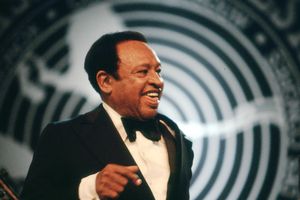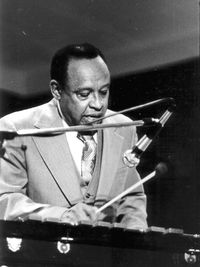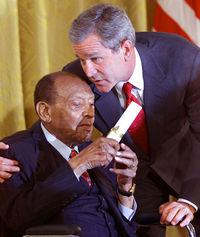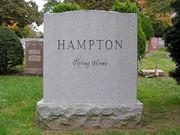Lionel Hampton
| Lionel Leo Hampton | |
|---|---|
 Lionel Hampton at the 1979 North Sea Jazz Festival |
|
| Background information | |
| Birth name | Lionel Leo Hampton |
| Also known as | "Hamp", "Mad Lionel" |
| Born | April 20, 1908 Louisville, Kentucky, U.S. |
| Died | August 31, 2002 (aged 94) New York City, New York, U.S. |
| Genres | Swing Big band Mainstream jazz New York blues |
| Occupations | Multi-instrumentalist Singer Actor Composer |
| Instruments | Vibraphone Drums Piano Vocals |
| Years active | 1927–2002 |
| Labels | Decca |
| Associated acts | Benny Goodman, Teddy Wilson, Quincy Jones, Louis Armstrong, Gloria Parker. |
Lionel Leo Hampton (April 20, 1908 – August 31, 2002) was an American jazz vibraphonist, pianist, percussionist, bandleader and actor. Like Red Norvo, he was one of the first jazz vibraphone players. Hampton ranks among the great names in jazz history, having worked with a who's who of jazz musicians, from Benny Goodman and Buddy Rich to Charlie Parker and Quincy Jones. In 1992, he was inducted into the Alabama Jazz Hall of Fame.
Contents |
Biography
Early life
Lionel Hampton was born in Louisville, Kentucky in 1908, and was raised by his grandmother. Shortly after he was born, he and his mother moved to her hometown Birmingham, Alabama.[1][2][3]. He spent his early childhood in Kenosha, Wisconsin before he and his family moved to Chicago, Illinois in 1916. As a youth, Hampton was a member of the Bud Billiken Club, an alternative to the Boy Scouts of America due to segregation.[4] During the 1920s—while still a teenager—Hampton took xylophone lessons from Jimmy Bertrand and started playing drums.[5] Hampton was raised Roman Catholic, and started out playing fife and drum at the Holy Rosary Academy near Chicago.[6]
Early career
Lionel Hampton began his career playing drums for the Chicago Defender Newsboy's Band while still a teenager in Chicago, a group that was led by Major N. Clark Smith. He moved to California in 1927 or 1928, playing drums for the Dixieland Blues-Blowers. He made his recording debut with The Quality Serenaders led by Paul Howard, then left for Culver City and drummed for the Les Hite band at Sebastian's Cotton Club. During this period he began practicing on the vibraphone. In 1930 Louis Armstrong came to California and hired the Les Hite band, asking Hampton if he would play vibes on two songs. So began his career as a vibraphonist, popularizing the use of the instrument ever since.[7]
While working with the Les Hite band, Hampton also occasionally did some performing with Nat Shilkret and his orchestra. During the early 1930s he studied music at the University of Southern California. In 1934 he led his own orchestra, and then appeared in the 1936 Bing Crosby film Pennies From Heaven alongside Louis Armstrong (wearing a mask in a scene while playing drums).[8]
With Benny Goodman
As far as I'm concerned, what he did in those days—and they were hard days, in 1937—made it possible for Negroes to have their chance in baseball and other fields.
Also in November 1936,[10] the Benny Goodman Orchestra came to Los Angeles to play the Palomar Ballroom. John Hammond brought Goodman to see Hampton play. Hampton backed Billie Holiday with the Goodman orchestra, which was discovered by Hammond.[11] and Goodman asked Hampton to join the Benny Goodman Trio, made up of Goodman, Teddy Wilson, and Gene Krupa, expanding it into the Benny Goodman Quartet. The Trio and Quartet were among the first racially integrated jazz groups to record and play before wide audiences,[12][13] and were a leading small-group in an era when jazz was dominated by big bands.
Lionel Hampton Orchestra

While Hampton worked for Goodman in New York, he recorded with several different small groups known as the Lionel Hampton Orchestra as well as assorted small groups within the Goodman band. In 1940 Hampton left the Goodman organization under amicable circumstances to form his own big band.[14]
Hampton's orchestra became very popular during the 1940s and early 1950s. His third recording with them in 1942 produced a classic version of "Flying Home", featuring a solo by Illinois Jacquet that paved the way for Rhythm & Blues. The selection became very popular, and so in 1944 Hampton recorded "Flying Home, Number Two" featuring Arnett Cobb. The song went on to become the theme song for all three men. Guitarist Billy Mackel first joined Hampton in 1944, and would perform and record with him almost continuously through the late 1970s.[15] In 1947 he recorded Stardust at a "Just Jazz" concert with Charlie Shavers and Slam Stewart produced by Gene Norman.
Hampton's band played in a jazz, merged with rhythm & blues vein from around 1945 to the early 1950s. Represented in recordings on Decca Records, the band included performers that achieved renown in their own right in the 1950s and 1960s, composer and bassist Charles Mingus, saxophonist Johnny Griffin, guitarist Wes Montgomery, vocalist Dinah Washington and keyboardist Milt Buckner. Other noteworthy performers in the orchestra then included trumpeters Dizzy Gillespie, Cat Anderson, Kenny Dorham and Snooky Young, trombonist Jimmy Cleveland and saxophonists Illinois Jacquet and Jerome Richardson.
In 1953 the orchestra toured Europe with Clifford Brown, Gigi Gryce, George Wallington and Art Farmer in his lineup; Quincy Jones was arranger/trumpeter and Annie Ross sang. Hampton continued to record with small groups and jam sessions during the 1940s and 1950s, with groups including Oscar Peterson, Art Tatum and Buddy DeFranco among others.[16]. In 1955 he was in California working on The Benny Goodman Story he was able to record sessions with Stan Getz and Art Tatum for Norman Granz as well as with his own big band.
Hampton performed with Louis Armstrong and Italian singer Lara Saint Paul at the 1968 Sanremo Music Festival in Italy. The performance created a sensation with Italian audiences, as it broke into a real jazz session.[17] That same year, Hampton received a Papal Medal from Pope Paul VI.
Later career

During the 1960s, Hampton's groups were in decline; he was still performing what had succeeded for him during the 1930s, 1940s, and 1950s. He did not fare much better in the 1970s, though he recorded actively on the Who's Who Record label.[18]
Beginning in February 1984, Hampton and his band played at the University of Idaho's annual jazz festival, which was renamed the Lionel Hampton Jazz Festival the following year. In 1987 the UI's school of music was renamed for Hampton, the first university music school named for a jazz musician.
Hampton remained active until a stroke in Paris in 1991 led to a collapse on stage. That incident, combined with years of chronic arthritis, forced him to cut back drastically on performances. However, he did play at the Smithsonian National Museum of American History in 2001 shortly before his death.[19][20][21]
Personal life
During the 1950s he had a strong interest in Judaism and raised money for Israel. In 1953 he composed a King David suite and performed it in Israel with the Boston Pops Orchestra. Later in life Hampton became a Christian Scientist.[22] Hampton's wife was his manager throughout much of his career. Many musicians recall that Lionel ran the music and Gladys ran the business. Hampton was a Thirty-three degree Prince Hall freemason in New York, also.[23] In January 1997, his apartment caught fire and destroyed his awards and belongings; Hampton escaped uninjured.[24]

Lionel Hampton died from congestive heart failure on August 31, 2002 at Mount Sinai Hospital in New York City, and is interred in the Woodlawn Cemetery, Bronx, New York. His funeral was held on September 7, 2002 and featured a performance by Wynton Marsalis and David Ostwald's Gully Low Jazz Band at Riverside Church in Manhattan; the procession began at The Cotton Club in Harlem.[25][26]
Charity

Hampton was deeply involved in the construction of various public housing projects, and founded the Lionel Hampton Development Corporation. Construction began with the Lionel Hampton Houses in Harlem, New York in the 1960s, with the help of then Republican governor Nelson Rockefeller. Hampton's wife—Gladys Hampton—also was very involved in construction of a housing project in her name—the Gladys Hampton Houses. Gladys died in 1971. In the 1980s, Hampton built another Housing project called Hampton Hills in Newark, New Jersey. Hampton was a staunch Republican and served as a delegate to several Republican National Conventions during his lifetime.[27] He served as Vice-Chairman of the New York Republican County Committee for some years[28] and also was a member of the New York City Human Rights Commission.[29]
Hampton donated close to $279,000 to Republican campaigns and committees during his lifetime.[30]
Awards
- 2001 - Harlem Jazz and Music Festival's Legend Award
- 1996 - National Medal of Arts presented by President Bill Clinton
- 1995 - Honorary Commissioner of Civil Rights by George Pataki
- 1995 - Honorary Doctorate from the New England Conservatory of Music
- 1993 - Honorary Doctorate from the University of Maryland Eastern Shore
- 1992 - Inducted into the Alabama Jazz Hall of Fame
- 1992 - "Contributions To The Cultural Life of the Nation" award from the John F. Kennedy Center for the Performing Arts
- 1988 - The National Endowment for the Arts Jazz Masters Fellowship
- 1988 - The National Association of Jazz Educators Hall of Fame Award
- 1987 - Honorary Doctorate of Humanities from the University of Idaho - UI's School of Music renamed "Lionel Hampton School of Music."
- 1987 - The Roy Wilkins Memorial Award from the NAACP
- 1986 - The "One of a Kind" Award from Broadcast Music, Inc.
- 1984 - Jazz Hall of Fame Award from the Institute of Jazz Studies
- 1984 - Honorary Doctorate of Music from USC
- 1983 - The International Film and Television Festival of New York City Award
- 1983 - Honorary Doctorate of Humane Letters from the State University of New York
- 1982 - Hollywood Walk of Fame Star
- 1981 - Honorary Doctorate of Humanities from Glassboro State College
- 1979 - Honorary Doctorate of Music from Howard University
- 1978 - Bronze Medallion from New York City
- 1976 - Honorary Doctorate of Humanities from Daniel Hale Williams University
- 1975 - Honorary Doctorate of Music from Xavier University of Louisiana
- 1974 - Honorary Doctorate of Fine Arts from Pepperdine University
- 1968 - Papal Medal from Pope Paul VI
- 1966 - George Frederick Handel Medal
- 1957 - American Goodwill Ambassador by President Dwight D. Eisenhower
- 1954 - Israel's Statehood Award
Discography
| Year | Album | Notes | Label |
|---|---|---|---|
| 1937–39 | Benny Goodman -The Complete RCA Victor Small Group Recordings | - | RCA Records |
| 1937–39 | Hot Mallets, Vol. 1 | - | Bluebird Records |
| 1937–39 | The Jumpin Five, Vol. 2 | - | Bluebird Records |
| 1938 | The Famous 1938 Carnegie Hall Jazz Concert | appearance as sideman for Benny Goodman | Columbia Records |
| 1939–40 | Tempo and Swing | appearances by Ben Webster, Coleman Hawkins and Nat "King" Cole | Bluebird Records |
| 1944 | Star Dust | the famous "Just Jazz" jam session | Verve Records |
| 1947 | with the Just Jazz All Stars | Charlie Shavers, Willie Smith, Corky Corcoran, Milt Buckner, Slam Stewart, Jackie Mills, Lee Young | GNP Crescendo/Vogue 78s/London Records 1972 transfer |
| 1953–54 | The Lionel Hampton Quintet | with DeFranco and Peterson. Includes a 17 minute jam on "Flyin Home". There is also a 5CD box of the complete Verve recordings of the quartets and quintets with Peterson, as well as a number of other compilations and selections. | Verve Records |
| 1955 | Hamp and Getz | Verve Records | |
| 1958 | The Golden Vibes | with a reed quintet | Columbia Records |
| 1958 | Lionel | Audio Fidelity | |
| 1960 | Silver Vibes | with a Trombones And Rhythms (Trombone Quartet) | Columbia Records |
| 1963 | Benny Goodman Together Again! | reunion with Lionel Hampton, Teddy Wilson & Gene Krupa | Columbia Records |
| 1963 | You Better Know It!!! | with Clark Terry, Ben Webster, Hank Jones, Milt Hinton, Osie Johnson | Impulse! Records |
| 1972 | Please Sunrise | Brunswick Record Corporation | |
| 1988 | Mostly Blues | Jazz Heritage Society | |
| 1991 | Live at the Blue Note | jamming with old friends including trombonist Al Grey | Columbia Records |
- Compilations
| Year | Album | Notes | Label |
|---|---|---|---|
| 37–40 | Swing Classics - Lionel Hampton and His Jazz Groups | Recordings from 1937-1940 Reissued 1961 | RCA Victor LPM-2318 |
| 39–56 | Greatest Hits | Selections from above records | RCA Victor |
| 42–63 | Hamp! | - | GRP/Decca |
| 37–63 | The Lionel Hampton Story | Selections from all records and eras above | Proper |
Filmography
| Year | Movie | Role | Director | Genre |
|---|---|---|---|---|
| 1933 | Girl Without A Room | himself | Ralph Murphy | Comedy |
| 1936 | Pennies From Heaven | himself | Norman Z. McLeod | Comedy/Musical |
| 1937 | Hollywood Hotel | himself | Busby Berkeley | Musical/Romance |
| 1938 | For Auld Lang Syne | himself | ? | Documentary |
| 1948 | A Song Is Born | himself | Howard Hawks | Comedy/Musical |
| 1949 | Lionel Hampton and His Orchestra | himself | Will Cowan | Music |
| 1955 | Musik, Musik and nur Musik | himself | Ernst Matray | Comedy |
| 1955 | The Benny Goodman Story | himself | Valentine Davies | Drama |
| 1957 | Mister Rock and Roll | himself | Charles S. Dubin | Drama/Musical |
| 1980 | But Then She's Betty Carter | himself | Michelle Parkerson | Documentary |
References
- ↑ Giddins, Gary (2002-09-23). "Lionel Hampton, 1908–2002; After 75 Years Onstage, a Well-Earned Rest". The Village Voice. http://www.villagevoice.com/music/0239,giddins,38597,22.html. Retrieved 2007-06-10.
- ↑ Percussive Arts Society Hall of Fame
- ↑ dnbv.nbs9896y0-United States Marine Band Hall of Composers
- ↑ Ehrenhalt, Alan (1996). The Lost City: The Forgotten Virtues of Community in America. Basic Books. p. 152. ISBN 0465041930.
- ↑ Yanow, Scott (2001). Classic Jazz. Backbeat Books. p. 94. ISBN 0879306599.
- ↑ "Ibid"; Voce, Steve
- ↑ Ibid"; Yanow, Scott
- ↑ Britt, Stan (1989). Dexter Gordon: A Musical Biography. Da Capo Press. p. 31. ISBN 0306803615.
- ↑ "Ibid"; Firestone, Ross p. 183-184.
- ↑ "Ibid"; Yanow, Scott. Swing - The Third...
- ↑ Scott, William B. (1999). New York Modern: The Arts and the City. Johns Hopkins University Press. p. 263. ISBN 0801867932.
- ↑ Firestone, Ross (1994). Swing, Swing, Swing: The Life & Times of Benny Goodman. W. W. Norton & Company. p. 183–184. ISBN 0393311686.
- ↑ "Ibid"; Scott, William B.
- ↑ Yanow, Scott (2000). Swing: Third Ear--The Essential Listening Companion. Backbeat Books. p. 68. ISBN 0879306009.
- ↑ "Billy Mackel", The New Grove Dictionary of Jazz. ed. Barry Kernfeld, 1988.
- ↑ "Ibid"; Yanow, Scott. Swing - The Third...
- ↑ Lara Saint Paul performs with Lionel Hampton and Louis Armstrong Lara Saint Paul - The Hits
- ↑ "Ibid"; Yanow, Scott. Swing - The Third...
- ↑ "Ibid"; Yanow, Scott. Swing - The Third...
- ↑ "Ibid"; Voce, Steve
- ↑ Celebrated Jazz Artist Lionel Hampton Donates His Vibes To Smithsonian
- ↑ "Ibid"; Voce, Steve
- ↑ Cox, Joseph (2002). Great Black Men of Masonry. iUniverse. p. 176. ISBN 0595227295.
- ↑ Barron, James (January 9, 1998). "PUBLIC LIVES; More Fallout From Lamp Fire". The New York Times. http://query.nytimes.com/gst/fullpage.html?res=980DE6D71F30F93AA35752C0A96E958260. Retrieved 2008-04-09.
- ↑ "Funeral Services for Lionel Hampton". The New York Times. September 5, 2002. http://query.nytimes.com/gst/fullpage.html?res=9D02E0DF143EF936A3575AC0A9649C8B63&scp=1&sq=Funeral+Services+for+Lionel+Hampton&st=nyt. Retrieved 2008-04-09.
- ↑ Lionel Hampton, Who Put Swing in the Vibraphone, Is Dead at 94
- ↑ Jackson, Jeffrey H. (2005). Music And History: Bridging The Disciplines. University Press of Mississippi. p. 102. ISBN 1578067626.
- ↑ "Paid Notice: Deaths HAMPTON, LIONEL". The New York Times. September 10, 2002. http://www.nytimes.com/2002/09/10/classified/paid-notice-deaths-hampton-lionel.html. Retrieved 2007-06-03.
- ↑ "Ibid"; Voce, Steve
- ↑ Lionel Hampton, 1908-2002
External links
- Lionel Hampton Library Collection, part of the International Jazz Collections at the University of Idaho Library
- Christopher Popa, "Lionel Hampton: Music Was His Fountain of Youth," Big Band Library
- Interview with Lionel Hampton by Felix Grant in 1982
- Lionel Hampton's Gravesite
- Lionel Hampton: His Life and Legacy at University of Idaho
- Lionel Hampton at Drummersworld
- Gene Krupa - What's New(s)
- Lionel Hampton Band - Midnight Sun 1947, Decca 28059 at YouTube
- Lionel Hampton Jazz Festival at University of Idaho
- Lionel Hampton at IMDB
- Official website of the Alabama Jazz Hall of Fame
- Photos at Jazzhouse.org
|
|||||